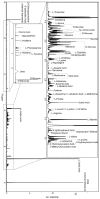NMR Spectroscopy for Metabolomics Research
- PMID: 31252628
- PMCID: PMC6680826
- DOI: 10.3390/metabo9070123
NMR Spectroscopy for Metabolomics Research
Abstract
Over the past two decades, nuclear magnetic resonance (NMR) has emerged as one of the three principal analytical techniques used in metabolomics (the other two being gas chromatography coupled to mass spectrometry (GC-MS) and liquid chromatography coupled with single-stage mass spectrometry (LC-MS)). The relative ease of sample preparation, the ability to quantify metabolite levels, the high level of experimental reproducibility, and the inherently nondestructive nature of NMR spectroscopy have made it the preferred platform for long-term or large-scale clinical metabolomic studies. These advantages, however, are often outweighed by the fact that most other analytical techniques, including both LC-MS and GC-MS, are inherently more sensitive than NMR, with lower limits of detection typically being 10 to 100 times better. This review is intended to introduce readers to the field of NMR-based metabolomics and to highlight both the advantages and disadvantages of NMR spectroscopy for metabolomic studies. It will also explore some of the unique strengths of NMR-based metabolomics, particularly with regard to isotope selection/detection, mixture deconvolution via 2D spectroscopy, automation, and the ability to noninvasively analyze native tissue specimens. Finally, this review will highlight a number of emerging NMR techniques and technologies that are being used to strengthen its utility and overcome its inherent limitations in metabolomic applications.
Keywords: GC-MS; LC-MS; MS; NMR; analytical platform; metabolomics; resolution; sensitivity.
Conflict of interest statement
The authors declare no conflict of interest.
Figures






References
Publication types
LinkOut - more resources
Full Text Sources
Miscellaneous

